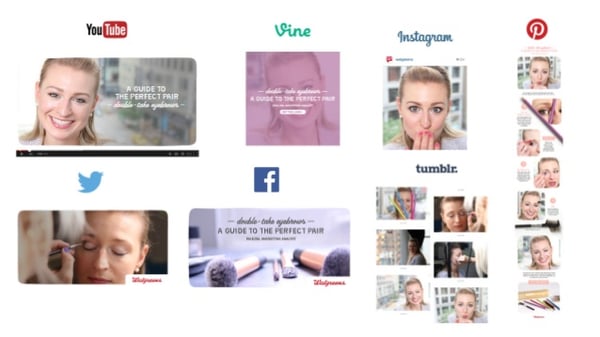TOP TALK
Social Media Week Chicago 2014: Building Brand Advocacy

Posted By Stephanie Malkus on October 10, 2014
Summarizing four days of nearly 140 events featuring the best and brightest in branded social media is quite a challenge. But if I had to, it comes down to one word: advocacy.
Imagine having customers who love your brand so much that they go out into the world of social media and share it with anyone who will listen. It sounds like a dream, right? That is the beauty of developing content that builds advocacy for your brand. It all starts with a great brand, of course, and a great social foundation. But ultimately, the goal is trust in your brand. How do you get there? Let's start with that goal in mind, and work our way back:
Build Trust
According to a 2012 survey by Nielsen, 92% of consumers say they trust earned media, such as recommendations from friends and family, above all other forms of advertising. This stat was shared by Paul Rand, CEO of Zocalo Group, during his Keynote: Who Moved My Social Cheese?
In addition to having an awesome title and hashtag, this talk shared some great thoughts on what marketers need to know to stay current in this constantly shifting landscape. One of those things was advocacy, particularly among millennials, who are a force to be reckoned with when it comes to digital advocacy. In fact, a study by SocialChorus found that 95% of millennials say friends are their most credible source of product information.
This drives home the point of building trust, to the point where consumers don't think twice about recommend your brand to their family and friends. Ensuring you're making engaging, strong, lasting and (most importantly) positive impressions with your audience on social media is increasing in importance.
Whether it's good or bad, we're all talking about brands, as evidenced by this stat, shared by WOMMA's (Word of Mouth Marketing Association) president, Suzanne Fanning, during her keynote: 2014 & Beyond: The Future of Going Social.
So, how do you achieve this trust? By building great relationships.
Build Relationships
Another very appreciated theme of Social Media Week Chicago was that old writer's adage: show, don't tell. So, instead of telling you how brands can build relationships with consumers, I'll show you, using some great examples shared during that same talk on the future of social media marketing by WOMMA's Fanning.
One example came from Honda. As a part of the Honda Cares campaign, the car company reached out to a small band that had made a music video, filmed inside their Hondas. Honda returned the love in a big way:
This is an example on a grand scale, but it doesn't have to be a nationally televised event. You can reach out to your already faithful following in smaller, but still significant ways.
B2B brands, I am talking to you, too. It's a commonly held belief that B2B companies face social media restrictions by their place in the business world, and that social is therefore more difficult on the B2B side. I'm here to tell you it doesn't have to be that way. It's not about being more careful with your social, but instead being more deliberate. This was another observation made by Zocalo Group's Paul Rand. Know who your audience is and share relevant content directly with them. Whether that means sharing infographics on LinkedIn or videos on Facebook or links to white papers on Twitter, do your homework and direct your social content efforts accordingly. That brings me to the final point, and where these efforts towards fostering an environment of advocacy have to start: great content.
Build Great Content
The final and most important secret is creating content that's worthy of the trust and relationships your brand has built, and consistently living up to the expectations of those loyal followers. Sounds like a daunting task, but it doesn't have to be. Social Media Week was full of tools and tricks to make this easier, but these were the take-home content lessons for me:
“Content doesn't work, if it doesn't move.” This was one of the opening statements made by Lauren Licata, content marketing manager at Belly, during her talk: Social Media Hacks to Fuel Your Content Marketing. Now, don't take that literally (although GIFs and video both make great content), but instead think in terms of format and engagement. If your content isn't finding your audience where they're at (i.e. Twitter, Facebook, Instagram, etc., and mobile vs. desktop) and moving them to action, then it's missing the point.
I saw this idea in practice during another talk: The Enterprise Content Roadmap. During this talk, Adam Kmiec, who handles social & content marketing for Walgreens, shared the brand's standards for content: They strive to providel content that is linked, liquid (e.g., must move across platforms and devices), and loved (meaning crafted with care). Your content must be able to move people to share it, wherever they are. Here's a great example featuring Walgreens content:

Notice how one great piece of relevant content was seamlessly shared across seven different social media platforms and made fresh and engaging on its unique platform. That's the idea behind liquid content that moves. If your content isn't finding your audience and moving them to action, then it's missing the point. Some of that has to come from you, ensuring you're doing your part to spread your brand's content on social, but it all starts with the creation of that content.
Creating great content people want to share is a bit of a balancing act between relevant and fun/quirky, a point made by the panel: Cut the Crap: Making Content that Moves People. Brands like Oreo, GE, and Starbucks have made headlines and endeared followers with great execution of the relevancy/quirky balance, but you don't have to be a behemoth brand to make impactful content that moves your followers to advocacy. You just have to listen.
One thing all of these brands do very well is take full advantage of user-generated content. Here's a great example from from Starbucks, who regularly #regrams photos from its loyal and enthusiastic following:
A #vanillabean @frappuccino + one shot of #espresso = Magic ✨#regram
It doesn't matter whether you have thousands, hundreds, or dozens of followers on social media: the fact is, you have a captive audience that's interested in your brand and wants to know what you have to say. So, return the favor and see what they have to say. Ask them to share their experiences---good and bad. See what unique ways they're using your product, and share those stories, whether they're images, videos, 140 character reviews, or whatever the next latest, greatest social trend may be. Your followers want to share, so let them. And, I'm sure this goes without saying, but make your intentions clear when asking for content from your followers. You don't want anyone getting upset that you shared their stories on social. Also, remember, brands cannot live on user-generated content alone, but it's a strong step towards building a stronger relationship and deepening trust between your brand and the consumer.
Thanks to social media, the brand/consumer relationship will never be the same. Consumers have come to expect an open and honest relationship with the brands they love. It's this kind of open sharing that's led to the level of brand advocacy we see today, a dream come true for brands and marketers alike. It's a give and take relationship, true, but it's one worth fostering.
Image Credit:
- Walgreens Image: The Enterprise Content Roadmap on SlideShare



